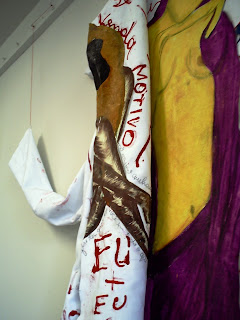
Visualizações do blog
sábado, 25 de abril de 2009
domingo, 19 de abril de 2009
SMS

http://rhizome.org/discuss/view/26108
acessado em: 01:47 segunda-feira, 20 de abril de 2009
Interview with Susana Mendes Silva by
Miguel Amado on June 7, 2007 10:01 am
MA: What are your interests as an artist?
SMS: My practice addresses the human condition in general and allegorically explores constraint in particular. Constraint can be related to a physical or a psychological condition as well as to an ethical positioning and socio-cultural conditioning. There are also related concepts playing an important role in my work: limit - in its physical and psychological meanings; impossibility - as an imposed boundary (by the self or by others); violence - as a visible or invisible exercise of force; affection - in the sense of a human feeling and of disease, either of the mind or the body; and desire - as a powerful human drive. I am very interested in subverting concepts, rules, and prevailing points of view. I am therefore committed to a critical vision about art and of the world.
acessado em: 01:47 segunda-feira, 20 de abril de 2009
Interview with Susana Mendes Silva by
Miguel Amado on June 7, 2007 10:01 am
MA: What are your interests as an artist?
SMS: My practice addresses the human condition in general and allegorically explores constraint in particular. Constraint can be related to a physical or a psychological condition as well as to an ethical positioning and socio-cultural conditioning. There are also related concepts playing an important role in my work: limit - in its physical and psychological meanings; impossibility - as an imposed boundary (by the self or by others); violence - as a visible or invisible exercise of force; affection - in the sense of a human feeling and of disease, either of the mind or the body; and desire - as a powerful human drive. I am very interested in subverting concepts, rules, and prevailing points of view. I am therefore committed to a critical vision about art and of the world.
segunda-feira, 13 de abril de 2009
monitoria: allan poe





























texto: edgar allan poe
o homem na multidão
Leitura da cidade como palimpsesto (composta de camadas sucessivas de construções e escritas – codificação – espera ser descoberto e lido); A cidade como texto literário que tem muitas interpretações (uma pluralidade de interpretações e sentidos, que, por sua vez, escondem mistérios à espera de revelação ou são indecifráveis; Tentativa frustrada de desvelar o enigma, fazer a cidade mais transparente e mais compreensível; Ler a cidade, portanto, é tentar torna-la legível, significa tentar analisar os significados que as cidades sugerem (essa a grande dificuldade), decifrar o mistério; Símbolo: o flâneur, que tinha a rua como morada, espaço de deambulação e com o olhar inteligente, mas desenraizado, contemplava, através da multidão, o espetáculo cambiante do efêmero e do contingente da cidade transformada pela Revolução Industrial; observação à-toa de sensações, a imagem urbana do ócio. É um ocioso paradoxal, que transforma a ociosidade em valor; O flâneur desenvolve em torno de si um escudo que o situa na massa urbana sem permitir que nela se envolva, seu contacto urbano é aquele do olhar, é a imagem da cidade sob a égide do olhar – fisionomista da imagem urbana; Ler/escrever a cidade é uma estratégia de legibilidade. " Perder-se também é caminho". (Clarice Lispector) Estratégias para a legibilidade: captar o momento, o instantâneo da cidade (todas as coisas têm um aspecto de novidade) – a questão impressionista.
quinta-feira, 2 de abril de 2009
Assinar:
Comentários (Atom)





22.JPG)
22.JPG)
22.JPG)
22.JPG)
22.JPG)



11.JPG)

11.JPG)
11.JPG)









